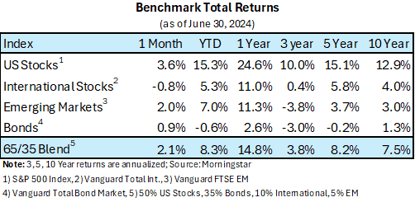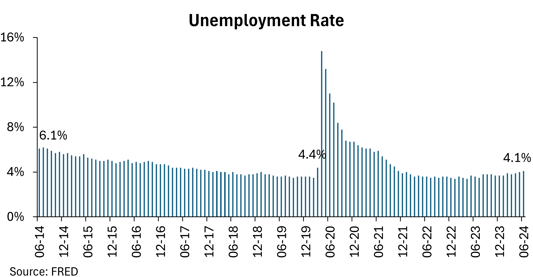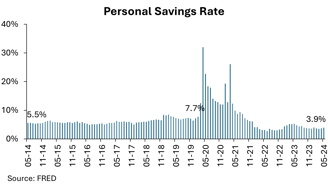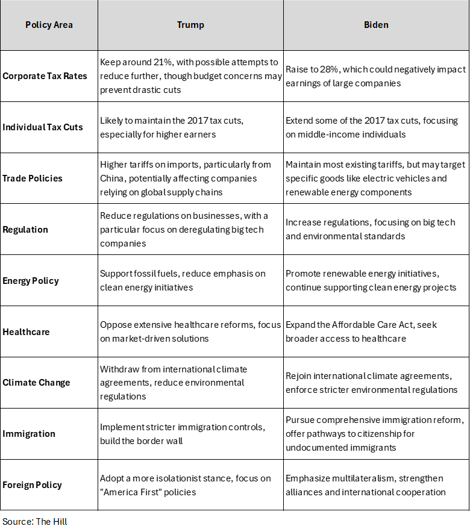Market Update: Good Times Keep Rolling, But Some Cracks in the Foundation
Despite a slowing job market and rising unemployment, the U.S. stock market remains resilient, though concerns grow as economic cracks appear.
MARKET UPDATE
Matt CFA, CFP®
7/8/20243 min read


What’s Happening with Jobs?
There have been some mixed signals about jobs in the U.S. The latest jobs report shows that the U.S. unemployment rate has increased to 4.1% in June 2024, up from 3.6% in the prior-year period. This rise indicates a broad slowdown in the labor market. While 206,000 new jobs were added in June, this number is largely driven by 70,000 new government jobs and 82,000 jobs in healthcare. Sectors like retail and leisure saw little to no growth. A significant drop of 49,000 temporary workers suggests that companies are cutting back on flexible labor, a pattern often seen before economic downturns.
The Fed is closely monitoring these developments. The rising unemployment rate and other warning signs might lead to a rate cut in September. The Fed is likely to signal this potential cut during their upcoming meeting later this month. The debate is shifting from whether the job market is slowing to how significant the weakening will be. The Fed's response will likely balance between controlling inflation and addressing the risk of a deeper labor market downturn.
Despite concerns about rising unemployment and mixed job signals, the stock market remains strong because companies are still making good profits and investors remain hopeful about the future. The Federal Reserve's potential rate cuts and the extra money from previous government stimulus also help keep the market up along with the continued insatiable appetite for technology stocks and AI.
A Closer Look at the US Consumer
U.S. consumers are getting savvy, hunting for deals and promotions while keeping their finances in check, according to Barclays. Although rising credit issues and late payments are on the radar, they haven't yet slowed down spending significantly. The overall financial health of consumers is still good, with higher-income households doing well and lower-income ones adjusting their spending due to economic pressures.
Despite some financial challenges, many households are dipping into their savings to keep spending steady. The personal saving rate remains low, showing that consumers are willing to use their reserves to maintain their current lifestyle but could indicate problems if unemployment increases.
The Impact of the 2024 U.S. Election on Stock Markets
As we approach the 2024 U.S. presidential election, it's crucial to understand how the results might influence the stock market. Whether President Biden retains his office, another democratic nominee wins, or former President Trump returns, the election outcomes will shape economic policies and the performance of various industries.
According to Barclays, the most likely outcome of the election is a divided government, where one party controls the House of Representatives and the other controls the Senate. A divided government often leads to legislative gridlock, making it challenging to pass new laws, particularly those related to spending and taxes. Check out the table below to see how the two candidates compare on major economic policies.
The upcoming election will significantly impact the U.S. stock market and could create some volatility. A divided government is anticipated, potentially limiting major policy changes. Depending on who wins the presidency, there could be important shifts in tax rates, trade policies, and regulations. Investors need to stay informed and prepare for potential market volatility as the election approaches. A Biden victory could lead to tighter regulations and higher taxes, potentially causing market jitters, especially in technology and healthcare sectors. Conversely, a Trump win might result in deregulation and lower taxes, boosting market sentiment, particularly in energy and industrial sectors. Investors should be prepared for short-term fluctuations as the market adjusts to the potential policy changes following the election.
The US market has been strong, but mixed job reports, cautious consumer behavior, and election uncertainty highlight the need for caution. Remember to maintain a diversified portfolio, as relying heavily on U.S. tech stocks could be risky. Diversification is key to navigating these uncertain times.








3857 Pell PL Unit 103 San Diego, CA 92130
mk@hevelcapital.com
(636) 236-9039
All content is for information purposes only. It is not intended to provide any tax or legal advice or provide the basis for any financial decisions. Nor is it intended to be a projection of current or future performance or indication or future results.
Opinions expressed herein are solely those of Hevel Capital, LLC and our editorial staff. The information contained in this material has been derived from sources believed to be reliable but is not guaranteed as to accuracy and completeness and does not purport to be a complete analysis of the materials discussed. All information and ideas should be discussed in detail with your individual adviser prior to implementation. Advisory services are offered by Hevel Capital, LLC an Investment Advisor in the State of California. Being registered as an investment adviser does not imply a certain level of skill or training.
The information contained herein should in no way be construed or interpreted as a solicitation to sell or offer to sell advisory services to any residents of any State other than the State of California or where otherwise legally permitted.
Images and photographs are included for the sole purpose of visually enhancing the website. None of them are photographs of current or former Clients. They should not be construed as an endorsement or testimonial from any of the persons in the photograph.
Purchases are subject to suitability. This requires a review of an investor’s objective, risk tolerance, and time horizons. Investing always involves risk and possible loss of capital.
